When do diagonal cracks occur in bridges? A short portrait of Dr. Sara Javidmehr from the Research Training Group 2075
The Research Training Group 2075 ”Modelling the constitutive evolution of building materials and structures with respect to aging” in the Core Research Area “Future City” at TU Braunschweig investigates the enhanced modelling and evaluation of existing structures as well as strengthening techniques. Dr. Sara Javidmehr completed her doctorate in the Research Training Group from October 2015 to August 2019. “Shear Capacity of Concrete Members under Monotonic and Cyclic Loading” is the title of her dissertation. We introduce the graduate with a short portrait.

Sara Javidmehr during a test in testing facilities of iBMB.
Picture credits: iBMB, Fachgebiet Massivbau der TU Braunschweig
Who are you and what is your research topic?
I grew up in Tehran (Iran) and have started my civil engineering studies at University of Tehran as a undergraduate student. During my bachelor studies, I had the chance to come to Germany for a foreign apprenticeship. Since then, I am fascinated in the well-structured testing and maintenance of bridges in Germany. Therefore, I decided to move to Germany for my Master studies at TU Berlin. In my PhD project at iBMB, Division of Concrete Construction as a member of Graduate School 2075, TU Braunschweig I have focused on shear capacity of existing concrete bridges.
Which research question are you working on?

Numerical evaluation of a shear test with the proposed crack model
Picture credits: iBMB/TU Braunschweig
The state of diagonal cracking under shear loading is a significant structural state for the assessment of existing concrete bridges with low shear reinforcement ratios. A main objective of my research was to develop analytical and numerical approaches to determine the diagonal cracking load. Besides, material damage under cyclic traffic loads is an important aspect for existing bridges, which was also a further objective of my research.
What inspires you about your research?
I find it quite inspiring to develop mechanical based models, which enable the simulation of the complex structural behavior of concrete structural elements.
Why is your topic relevant to the Future City?
Talking about Future City, we often imagine new modern constructions. One of the major future challenges of civil engineers will be to assure the structural resistance of existing structures. This was also the focus of my PhD research.
What is special about participating in the Research Training Group “Modelling the constitutive evolution of building materials and structures with respect to aging”?
One of the special things about the graduate school is the possibility to exchange with other members about their research and evaluation methods. Although we focus on somehow different topics, we can profit and learn about the scientific methods of each other.

